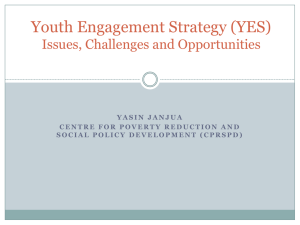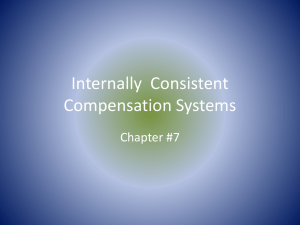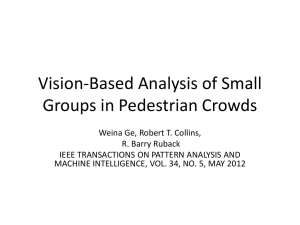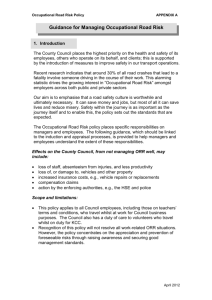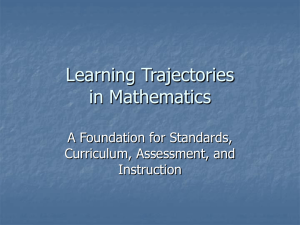Getting ahead. Educational and occupational trajectories of the `new
advertisement
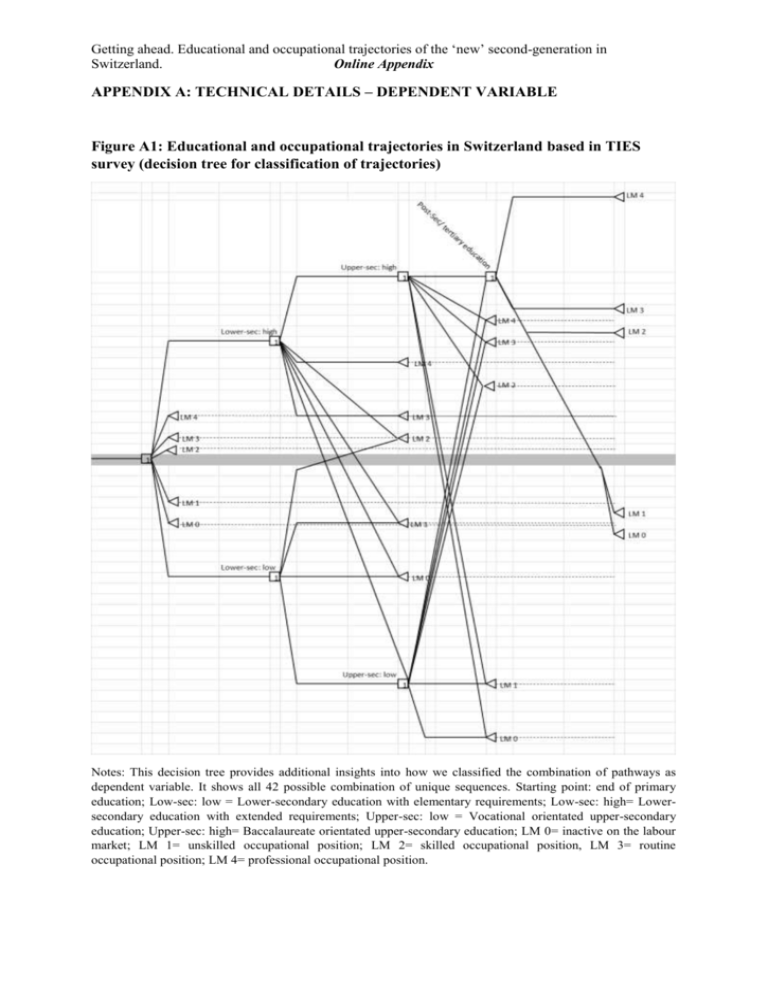
Getting ahead. Educational and occupational trajectories of the ‘new’ second-generation in Switzerland. Online Appendix APPENDIX A: TECHNICAL DETAILS – DEPENDENT VARIABLE Figure A1: Educational and occupational trajectories in Switzerland based in TIES survey (decision tree for classification of trajectories) Notes: This decision tree provides additional insights into how we classified the combination of pathways as dependent variable. It shows all 42 possible combination of unique sequences. Starting point: end of primary education; Low-sec: low = Lower-secondary education with elementary requirements; Low-sec: high= Lowersecondary education with extended requirements; Upper-sec: low = Vocational orientated upper-secondary education; Upper-sec: high= Baccalaureate orientated upper-secondary education; LM 0= inactive on the labour market; LM 1= unskilled occupational position; LM 2= skilled occupational position, LM 3= routine occupational position; LM 4= professional occupational position. Getting ahead. Educational and occupational trajectories of the ‘new’ second-generation in Switzerland. Online Appendix Additional information on classification of trajectories Based on the decision tree presented above, related trajectories were first clustered into 10 distinct groups which were then further classified into four major ‘families of trajectories’ (compare Table A1, below). Constant successful trajectories 1. Straight up: lower secondary education with extended requirements, baccalaureateoriented upper secondary education, tertiary education, executive and professional workers. 2. Straight medium: lower secondary education with extended requirements, baccalaureate-oriented upper secondary education, routine or skilled worker. Upward trajectories 3. Upward mobility – labor market: lower secondary education with elementary requirements, vocational-training-oriented upper secondary education, skilled or routine worker. 4. Upward mobility – education: lower secondary education with elementary requirements, baccalaureate-oriented upper secondary education, routine or skilled worker (few cases also followed tertiary education before entering the labor market). 5. Upward mobility – education and labor market: lower secondary education with elementary requirements, baccalaureate-oriented upper secondary education, executive and professional workers. 6. Bumpy (discontinuous) upward mobility: lower secondary education with extended requirements, vocational-training-oriented upper secondary education, executive and professional workers. Downward trajectories 7. Downward mobility – education: lower secondary education with extended requirements, vocational-training-oriented upper secondary education, unskilled worker or inactive. 8. Downward mobility – labor market: lower secondary education with extended requirements, baccalaureate-oriented upper secondary education, unskilled worker or inactive. Getting ahead. Educational and occupational trajectories of the ‘new’ second-generation in Switzerland. Online Appendix 9. Bumpy (discontinuous) downward mobility: lower secondary education with elementary requirements, baccalaureate-oriented upper secondary education, unskilled worker or inactive. Constant unsuccessful pathway 10. Straight low: lower secondary education with elementary requirements, vocationaltraining-oriented upper secondary education (at maximum), unskilled worker or inactive. Getting ahead. Educational and occupational trajectories of the ‘new’ second-generation in Switzerland. Table A1: Classification of trajectories (dependent variable) Online Appendix Getting ahead. Educational and occupational trajectories of the ‘new’ second-generation in Switzerland. Source: TIES Survey Switzerland (2007-08) Online Appendix Getting ahead. Educational and occupational trajectories of the ‘new’ second-generation in Switzerland. Online Appendix APPENDIX B: ADDITIONAL ESTIMATIONS Table B1: Multinomial logistic regression of educational and occupational pathways: Final model (Reference category: constant successful paths, average marginal effects) Upward trajectories Ref. Majority group 2nd Generation Turkey 2nd Generation W. Balkan 0.136 * 0.110 * Downward trajectories Unsuccessful trajectories -0.086 -0.040 -0.007 -0.013 Female -0.017 -0.047 * Parental SES Family size above average Exoneration from household obligations Family cohesion Parent-child communication -0.070 ** 0.041 0.030 -0.042 + -0.029 ** 0.019 -0.001 0.007 0.025 + -0.009 -0.006 -0.018 + -0.008 0.006 -0.002 Has children Attitudes towards compatibility of family and work Self-efficacy -0.035 Above-average support by teachers Feelings of being discriminated against Proportion Swiss peers in school Proportion Swiss peers today Adj. R2 (McFadden) % correctly predicted Observations -0.002 0.025 * 0.012 + -0.052 + -0.063 -0.093 0.049 + 0.015 0.050 * -0.018 -0.007 -0.017 ** -0.018 ** -0.047 * -0.027 * 0.039 0.043 -0.024 0.012 -0.001 -0.071 * 0.22 56.9 1107 Notes: Statistical significance: + p<0.10, * p<0.05, ** p<0.01, *** p<0.001. All models are controlled for age and urban area of residence. Source: TIES Survey Switzerland (2007-08) Getting ahead. Educational and occupational trajectories of the ‘new’ second-generation in Switzerland. Online Appendix Table B2: Multinomial logistic regression of divergent types of upward mobility trajectories (Reference category: Education and Work, average marginal effects) ED LM Ref. Majority group 2nd Generation Turkey 2nd Generation W. Balkan -0.049 0.053 -0.009 -0.091 Female -0.101 * 0.035 Parental SES Family size above average Exoneration from household obligations Family cohesion Parent-child communication -0.059 * -0.061 + 0.004 + 0.020 Has children Attitudes towards compatibility of family and work Self-efficacy Above-average support by teachers Feelings of being discriminated against Proportion Swiss peers in school Proportion Swiss peers today Adj. R2 (McFadden) % correctly predicted Observations -0.012 0.008 0.006 0.011 -0.007 -0.022 0.032 -0.003 -0.046 ** -0.014 + 0.015 -0.006 0.002 -0.038 0.012 -0.068 0.012 -0.031 -0.009 -0.008 0.16 52.1 610 Notes:. ED= Upward mobility through education. LM= Upward mobility through the labour market. Statistical significance: + p<0.10, * p<0.05, ** p<0.01, *** p<0.001. All models are controlled for age and urban area of residence. Source: TIES Survey Switzerland (2007-08) Getting ahead. Educational and occupational trajectories of the ‘new’ second-generation in Switzerland. Online Appendix APPENDIX C: SWISS EDUCATION SYSTEM Figure C1: The Swiss Education System

